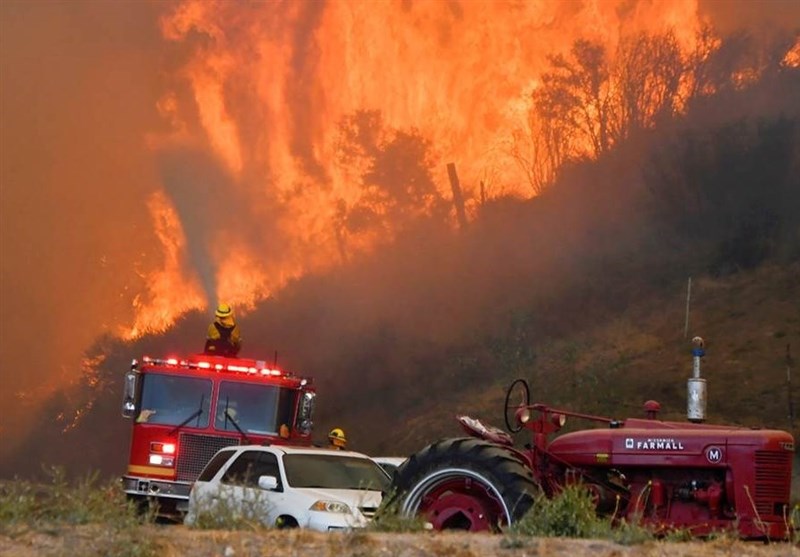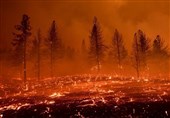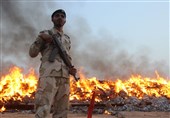Wildfires Rage across Western US As Adverse Weather Looms
TEHRAN (Tasnim) – As firefighters continued battling massive wildfires raging across the western United States on Friday, their efforts are expected to face significant challenges this weekend due to high temperatures and approaching thunderstorms.
In Northern California, the Park Fire is currently the largest fire burning in the country and became the fourth-largest wildfire in the state's history with the burn area reaching 399,615 acres as of Friday afternoon, according to the California Department of Forestry and Fire Protection, Xinhua reported.
Firefighters had made notable progress over the past three days, increasing containment to 25 percent as of Friday afternoon. However, "while containment is growing, the fire continues to burn actively in areas with thick, dry vegetation that is receptive to burning," said CalFire in an update.
The agency warned of "critical weather" expected through the weekend, with higher temperatures, lower humidity, and strong winds potentially leading to extreme fire behavior and multi-directional growth.
The challenging terrain complicated firefighting efforts, hampering radio communications and making it difficult for crews to access certain areas, said CalFire.
A total of 6,375 personnel, supported by 41 helicopters, 542 engines, 180 dozers, and 148 water tenders, continued to battle the blaze along more than 320 km of the active fire front, said CalFire.
The fire has affected four counties, namely Butte, Plumas, Shasta, and Tehama, with Tehama seeing the largest burn area and Butte reporting the most damage.
As of Friday afternoon, 542 structures have been destroyed and 50 others damaged in Butte and Tehama counties. About 4,000 people have been evacuated. No death has been reported so far.
Authorities said the fire was deliberately set on July 24 in a park near Chico. A 42-year-old man, named Ronnie Dean Stout II, of Chico, has been arrested on the charge of felony arson for allegedly starting the fire.
The Park Fire is only one of the dozens of wildfires torching the state.
Two new blazes, the Nixon Fire and the Pedro Fire, ignited earlier this week, and have rapidly spread to over 5,200 acres and 3,800 acres respectively. Firefighters have made some headway, with the Nixon Fire 30 percent contained and the Pedro Fire 35 percent contained as of Friday.
Meanwhile, Colorado is grappling with its own wildfire crisis. The Alexander Mountain Fire, first reported on Monday, has grown to 9,194 acres near the Roosevelt National Park, with only 5 percent contained, according to InciWeb, an interagency all-risk incident information management system.
This blaze has already claimed one life and damaged or destroyed at least two dozen structures in Larimer County. Since igniting on Thursday, another newly reported fire, the Bucktail Fire, has quickly consumed 2,046 acres of thickly forested land near Nucla.
In Oregon, firefighters are bracing for potential lightning strikes as monsoonal moisture moves into the region.
The Durkee Fire, currently the second-largest active fire in the United States, has burned through 293,882 acres and been 63 percent contained, according to InciWeb.
The approaching monsoon doesn't necessarily mean increased rainfall, but rather a shift in wind direction that could bring more moisture and the threat of thunderstorm activity, according to a weather report by the TV station KOIN on Friday.
The 2024 fire season has hit California particularly hard. As of Thursday, the state had experienced a staggering 2,905 percent increase in burned acreage compared with 2023, as 768,137 acres have been consumed by 4,696 wildfires, according to CalFire.
Across the western United States, firefighters were battling over 90 large active wildfires on Friday, with 28 fires prompting evacuation orders. According to the National Interagency Fire Center, California and Oregon have a combined 45 large fires burning on Friday.
The center attributed this surge in fire activity to record-high temperatures and prolonged heat waves that have left much of the West with dangerously dry vegetation.






